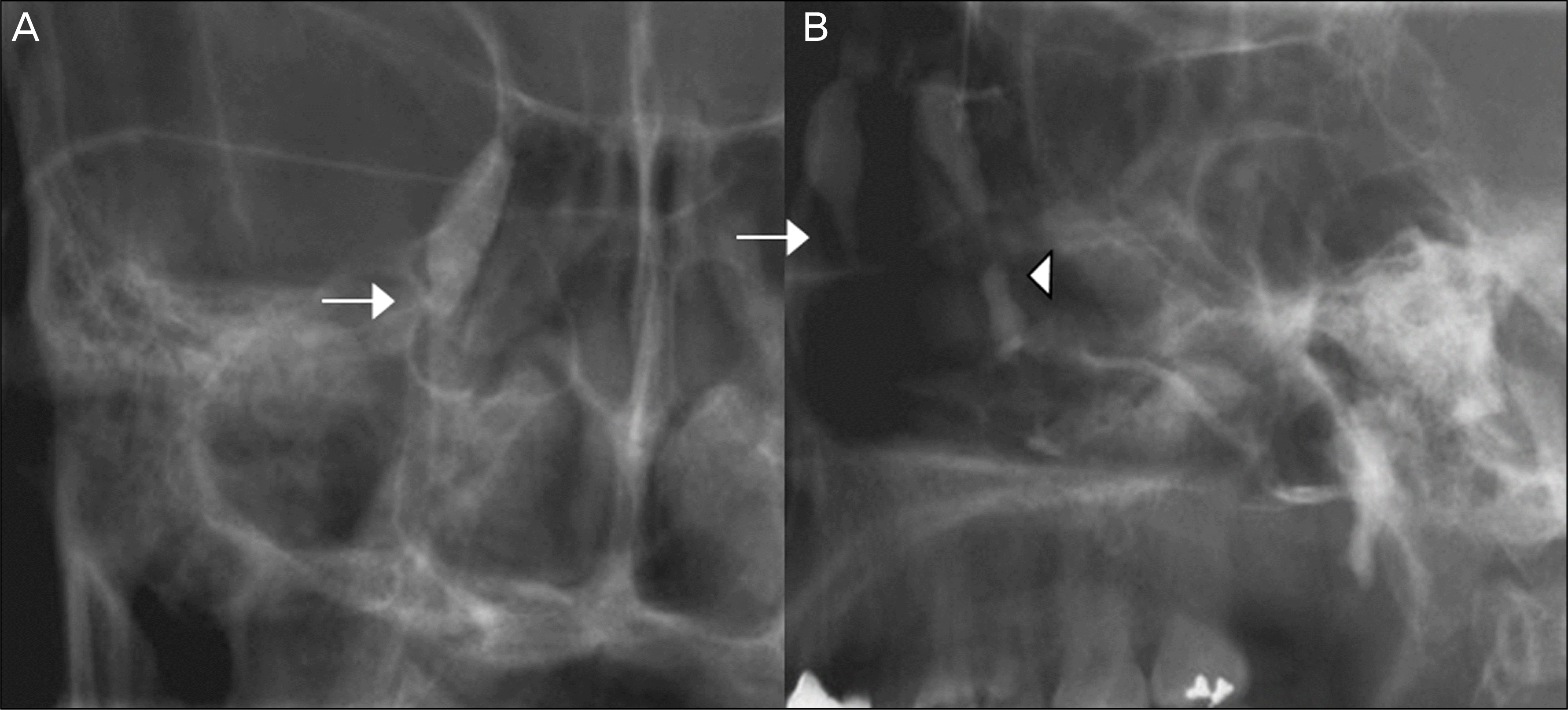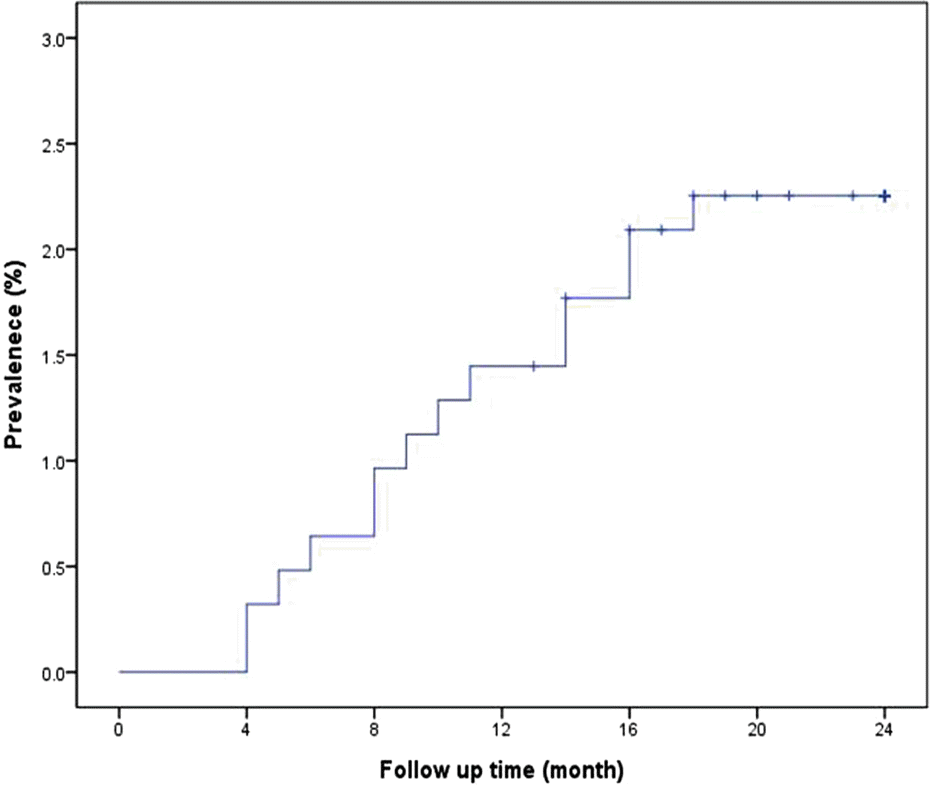Abstract
Purpose
To investigate the clinical manifestation of nasolacrimal duct obstruction after radioactive iodine therapy for thyroid cancer.
Methods
The authors examined 622 patients who were treated with radioactive iodine therapy after the operation for thyroid cancer from January 2009 to December 2011. Fourteen patients (18 eyes) were diagnosed nasolacrimal duct obstruction based on the lacrimal irrigation test, lacrimal probing test and dacryocystography in our oculoplastic clinic. We an-alyzed the dose of radioactive iodine therapy, number of treatments, clinical manifestation and treatment type by retro-spectively reviewing the patients’ medical records.
Results
The mean radioactive iodine dose (215.7 ± 23.1 mCi, p = 0.01) and the mean number of treatments (1.36 ± 0.50, p < 0.001) were significantly greater in 14 patients who had nasolacrimal duct obstruction than in patients who did not. The average onset of tearing symptoms occurred 10.2 months after radioactive iodine therapy. The mean time between correct diagnosis and therapy was 18.4 months. Three patients (3 eyes) had occlusion at the common cannaliculus and 11 patients (15 eyes) had occlusion at the nasolacrimal duct. Ten patients (13 eyes) underwent endonasal dacryocysto-rhinostomy for complete obstruction and 4 patients (5 eyes) underwent silicone tube intubation for partial obstruction.
Go to : 
References
1. Sawka AM, Brierley JD, Tsang RW. . An updated systematic review and commentary examining the effectiveness of radioactive iodine remnant ablation in well-differentiated thyroid cancer. Endocrinol Metab Clin North Am. 2008; 37:457–80.

2. Ahn HY, Park YJ.Incidence and clinical characteristics of thyroid cancer in Korea. Korean J Med. 2009; 77:537–42.
3. Alexander C, Bader JB, Schaefer A. . Intermediate and long-term side effects of high-dose radioiodine therapy for thyroid carcinoma. J Nucl Med. 1998; 39:1551–4.
4. Kloos RT, Duvuuri V, Jhiang SM. . Nasolacrimal drainage sys-tem obstruction from radioactive iodine therapy for thyroid carcinoma. J Clin Endocrinol Metab. 2002; 87:5817–20.

5. Burns JA, Morgenstern KE, Cahill KV. . Nasolacrimal obstruction secondary to I131 therapy. Ophthal Plast Reconstr Surg. 2004; 20:126–9.

6. Venkataraman GM, Yatin M, Ain KB.Cloning of the human sodium-iodide symporter promoter and characterization in a differ-entiated human thyroid cell line, KAT-50. Thyroid. 1998; 8:63–9.

7. Spitzweg C, Joba W, Eisenmenger W, Heufelder AE.Analysis of human sodium iodide symporter gene expression in extrathyroidal tissues and cloning of its complementary deoxyribonucleic acids from salivary gland, mammary gland, and gastric mucosa. J Clin Endocrinol Metab. 1998; 83:1746–51.

8. Morgenstern KE, Vadysirisack DD, Zhang Z. . Expression of sodium iodide symporter in the lacrimal drainage system: im-plication for the mechanism underlying nasolacrimal duct obstruction in I(131)-treated patients. Ophthal Plast Reconstr Surg. 2005; 21:337–44.

9. Shepler TR, Sherman SI, Faustina MM. . Nasolacrimal duct obstruction associated with radioactive iodine therapy for thyroid carcinoma. Ophthal Plast Reconstr Surg. 2003; 19:479–81.

10. Bakheet SM, Hammami MM, Hemidan A. . Radioiodine se-cretion in tears. J Nucl Med. 1998; 39:1452–7.
11. Brockmann H, Wilhelm K, Joe A. . Nasolacrimal drainage obstruction after radioiodine therapy: case report and a review of the literature. Clin Nucl Med. 2005; 30:543–5.

12. Kilfoy BA, Zheng T, Holford TR. . International patterns and trends in thyroid cancer incidence, 1973-2002. Cancer Causes Control. 2009; 20:525–31.

13. The Korea Central Cancer Registry, National Cancer Center. Annual report of cancer statistics in Korea in 2009, Ministry of Health and Welfare. 2011.
14. Solans R, Bosch JA, Galofré P. . Salivary and lacrimal gland dysfunction (sicca syndrome) after radioiodine therapy. J Nucl Med. 2001; 42:738–43.
Go to : 
 | Figure 1.In forty-year-old woman (Case 13), dacryocystography (A: Coronary view; B: Right Oblique view) shows complete obstruction of the right lacrimal pathway at the level of the Krause’s valve (arrow) and pervious and morpho-logically normal left lacrimal pathway (arrow head). |
 | Figure 2.Survival analysis graph. The follow-up time from the initiation of radioactive iodine therapy is indicated on the horizontal axis and the prevalence of nasolacrimal duct obstruction is indicated on the vertical axis. Prevalance was 0.3% at 4 months, 0.9% at 8 months, 1.9% at 12 months, and 2.1% at 16 months. Total prevalance was 2.2%. Mean out-break time was 10.2 months. |
Table 1.
Basic characteristics comparison between NLD obstruction group and non-NLD obstruction group
| NLD obstruction (n = 14) | non-NLD obstruction (n = 608) | p-value | ||
|---|---|---|---|---|
| Age (years) | 45 ± 6 | 48 ± 11 | 0.19* | |
| Sex | Male (%) | 1 (7.1) | 101 (16.6) | 0.41† |
| Female (%) | 13 (92.9) | 507 (83.4) | ||
| 131I radiation doses (mCi) | 215.7 ± 87.2 | 146.8 ± 68.0 | 0.01* | |
| Number of 131I radiation therapy | 1.36 ± 0.5 | 1.07 ± 0.3 | <0.001† | |
Table 2.
Clinical data of 14 patients, dermographics, findings and treatment




 PDF
PDF ePub
ePub Citation
Citation Print
Print


 XML Download
XML Download